NCERT Solution (Part - 3) - Financial Statements - II | Accountancy Class 11 - Commerce PDF Download
Q9: From the following balances of M/s Jyoti Exports, prepare trading and profit and loss account for the year ended March 31, 2017 and balance sheet as on this date.
 Closing stock Rs 10,000.
Closing stock Rs 10,000.
1. To provision for doubtful debts is to be maintained at 5 per cent on sundry debtors.
2. Wages amounting to Rs 500 and salary amounting to Rs 350 are outstanding.
3. Factory rent prepaid Rs 100.
4. Depreciation charged on Plant and Machinery @ 5% and Building @ 10%.
5. Outstanding insurance Rs 100.
Ans:

 Note: As per solution Net Profit is Rs 15,890 and Total of the Balance Sheet is Rs 76,940. However, NCERT shows Net Profit Rs 15,895 and Total of the Balance Sheet Rs 76,945.
Note: As per solution Net Profit is Rs 15,890 and Total of the Balance Sheet is Rs 76,940. However, NCERT shows Net Profit Rs 15,895 and Total of the Balance Sheet Rs 76,945.
Q10: The following balances have been extracted from the books of M/s Green House for the year ended December 31, 2017, prepare trading and profit and loss account and balance sheet as on this date.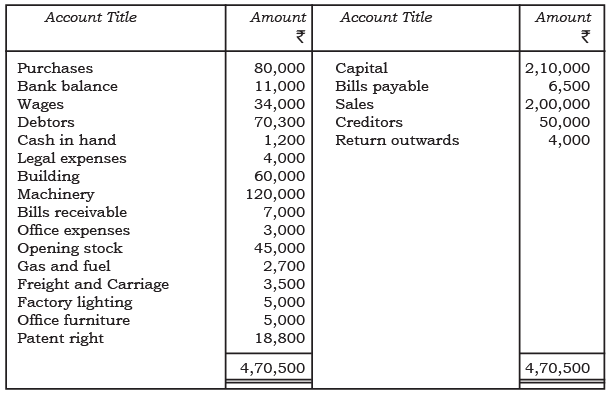 adjustments :
adjustments :
(a) Machinery is depreciated at 10% and buildings depreciated at 6%.
(b) Interest on capital @ 4%.
(c) Outstanding wages Rs 50.
(d) Closing stock Rs 50,000.
Ans:
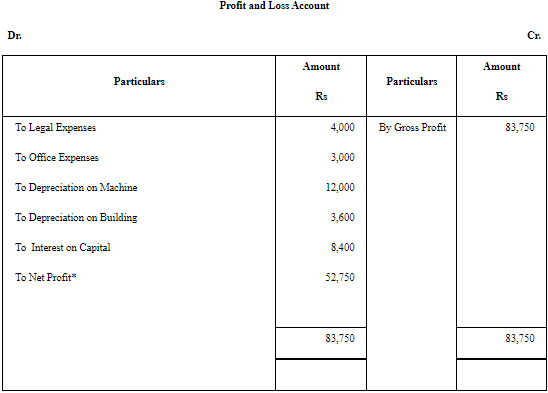

Question.11 : From the following balances extracted from the book of M/s Manju Chawla on March 31, 2017. You are requested to prepare the trading and profit and loss account and a balance sheet as on this date. Closing stock was Rs 2,000.
Closing stock was Rs 2,000.
(a) Interest on drawings @ 7% and interest on capital @ 5%.
(b) Land and Machinery is depreciated at 5%.
(c) Interest on investment @ 6%.
(d) Unexpired rent Rs 100.
(e) Charge 5% depreciation on furniture.
Answer :
Trading Account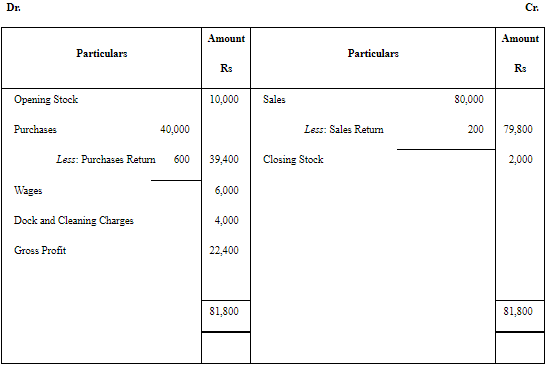 Profit and Loss Account
Profit and Loss Account 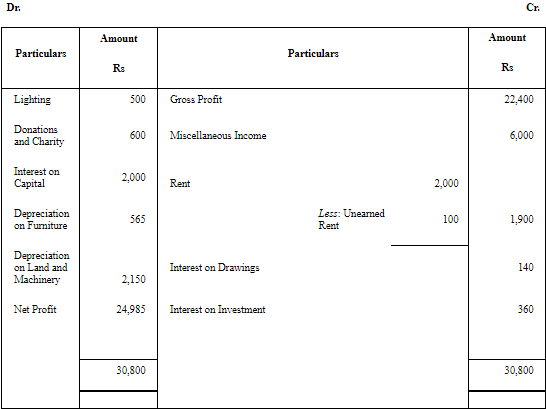 Balance Sheet
Balance Sheet  Note: In the NCERT textbook, the answer provided for question number 11 is different from the solution. However, the answer should be
Note: In the NCERT textbook, the answer provided for question number 11 is different from the solution. However, the answer should be
Gross profit = Rs 22,400 instead of Rs 21,900
Net profit = Rs 24,985 instead of Rs 25,185
Total of Balance Sheet = Rs 72,945 instead of Rs 71,185
Q12: The following balances were extracted from the books of M/s Panchsheel Garments on March 31, 2017. 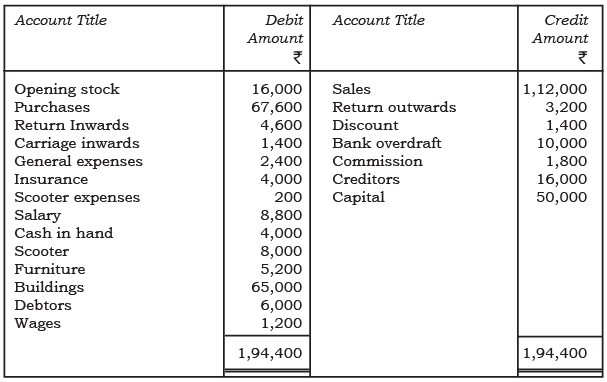 Prepare the trading and profit and loss account for the year ended March 31, 2017 and a balance sheet as on that date.
Prepare the trading and profit and loss account for the year ended March 31, 2017 and a balance sheet as on that date.
(a) Unexpired insurance Rs 1,000.
(b) Salary due but not paid Rs 1,800.
(c) Wages outstanding Rs 200.
(d) Interest on capital 5%.
(e) Scooter is depreciated @ 5%.
(f) Furniture is depreciated Rs @ 10%.
Answer : Trading Account
Profit and Loss Account  Balance Sheet
Balance Sheet 
Q13: Prepare the trading and profit and loss account and balance sheet of M/s Control Device India on December 31, 2017 from the following balance as on that date. Closing stock was valued Rs 20,000.
Closing stock was valued Rs 20,000.
(a) Interest on capital @ 10%.
(b) Interest on drawings @ 5%.
(c) Wages outstanding Rs 50.
(d) Outstanding salary Rs 20.
(e) Provide a depreciation @ 5% on plant and machinery.
(f) Make a 5% provision on debtors.
Ans:
Trading Account Profit and Loss Account
Profit and Loss Account 
Balance Sheet 
Q14: The following balances appeared in the trial balance of M/s Kapil Traders as on March 31, 2017 The partners of the firm agreed to records the following adjustments in the books of the Firm: Further bad debts Rs.300. Maintain provision for bad debts 10%. Show the following adjustments in the bad debts account, provision account, debtors account, profit and loss account and balance sheet.
The partners of the firm agreed to records the following adjustments in the books of the Firm: Further bad debts Rs.300. Maintain provision for bad debts 10%. Show the following adjustments in the bad debts account, provision account, debtors account, profit and loss account and balance sheet.
Ans:
Profit and Loss Account 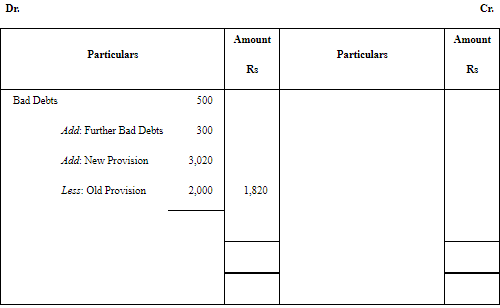

 Bad Debts Account
Bad Debts Account
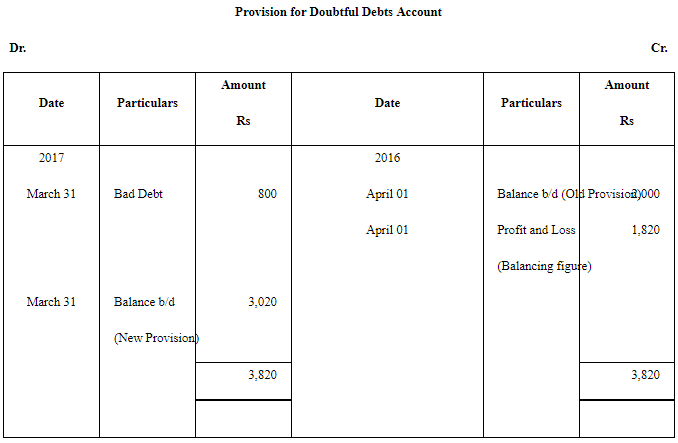
Q15: Prepare the bad debts account, provision for account, profit and loss account and balance sheet from the following information as on December 31, 2017
Adjustments:
Bad Debts Rs 500 Provision on Debtors @ 3%.
Ans:


Balance Sheet  Bad Debts Account
Bad Debts Account 
 Note: In this case, the old provision exceeds the sum total of Bad debts and the New Provision. Thus, the balancing figure is Rs 115 and is calculated as Rs 2,500 + Rs 2,385 – Rs 5,000 = Rs (115)
Note: In this case, the old provision exceeds the sum total of Bad debts and the New Provision. Thus, the balancing figure is Rs 115 and is calculated as Rs 2,500 + Rs 2,385 – Rs 5,000 = Rs (115)
|
61 videos|154 docs|35 tests
|
FAQs on NCERT Solution (Part - 3) - Financial Statements - II - Accountancy Class 11 - Commerce
| 1. What are the key components of a financial statement? |  |
| 2. How do financial statements help in decision-making for a business? |  |
| 3. What is the difference between the cash flow statement and the income statement? |  |
| 4. Why is it important to prepare financial statements at the end of an accounting period? |  |
| 5. What role do financial ratios play in analyzing financial statements? |  |






















